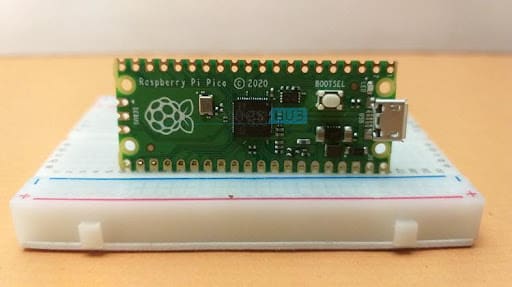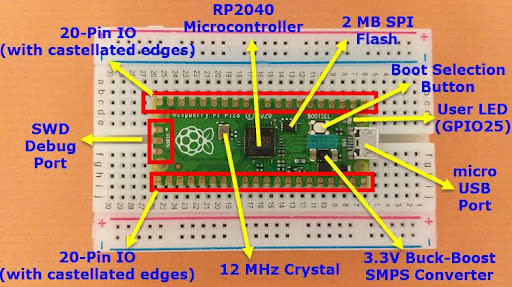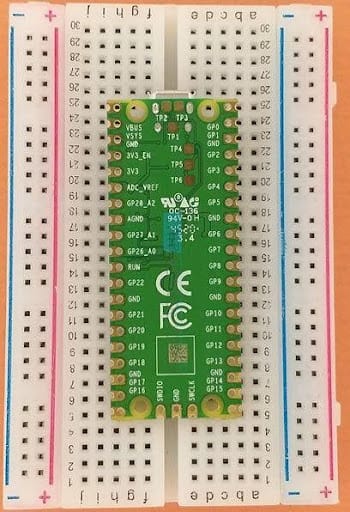Raspberry Pi Pico is amongst the recent Raspberry Pi Foundation's products. It is an affordable Raspberry Pi board for the RP2040. The Raspberry Pi Pico is not a replacement for the PCBs that are currently available on the market for purchase. You could surf the web, modify documents, watch movies, try out some games, and perform numerous other functions with a normal Raspberry Pi. However, Pico is incapable of performing those sorts of activities. You could utilize it to interface detectors, work on LEDs, and design different physical computing utilizations owing to the fact that it is a microprocessor development board.
Features of Raspberry Pi Pico
The Pico is a PCB that possesses a microprocessor, a few key parts, and castellated corners. There is a chance for you to get this board soldered to another PCB as it possesses edge castellations.
Assume you are currently handling a task that utilizes an RP2040 microprocessor. You must construct the power supply chip, the clock chip, the USB chip, and other chips if you utilize a naked microprocessor device in your hardware. This is the least feature needed for RP2040 to begin functioning.
You could utilize the Pico as a foundation board in your hardware and create only the crucial sections of the program because the Pico already possesses all of these circuits on-board. This method decreases the hardware manufacturers efforts and the period of marketing for the product.
Raspberry Pi Pico Pinout
The whole Pico Pinout data is shown in the figure below. From the pictorial illustration, you could observe that it possesses forty pins with twenty on each long edge. You could also see that twenty-six of those pins are GPIO pins while the remaining fourteen are power and system related pins. It also possesses three additional pins that are meant solely for SWD Debugging accompanying the forty pins.
Getting Started with Raspberry Pi Pico
The Raspberry Pi Pico is unlike every other preceding version. Pico remains the first gadget that employed the RP2040, a proprietary SoC with a twin core Arm Cortex M0+ operating at 133 MHz.
The Pico's only flaw is its lack of wireless connection. The RP2040 is the Pi's first microprocessor, and it introduces a fresh method of operating. Because the Pico is not a PC, we must create code in a separate program on another PC and then “flash” it to the microprocessor over USB.
Design of the Board
The structure of the Pico board is seen in the figure below. As you will observe, the forty GPIO pins lack headers but still contain holes for us to solder our own. The forty GPIO pins and the three debug pins feature castellated corners.
So, whenever you plan on constructing a breakout board with Pico, you could simply get your Pico to be soldered by utilizing the corners.
Another crucial (and sometimes frustrating) characteristic is that there are no pin labels on its top. Rather they are at the bottom. As a result, you ought to possess a printout that features the Pinout Diagram.
Utilizing the Raspberry Pi Pico for Programming
Raspberry Pi, like most microprocessors out there, features a C/C++ toolchain for the RP2040 microprocessor. This little man, however, could run the MicroPython structure thanks to its enormous power.
This gadget, in particular, is compatible with firmware updates through USB when utilized as a storage gadget. The moment you press the BOOTSEL button after you have gotten the Pico plugged in, you could input mass-storage mode and get the summarized binary copied to the mounted drive, then go ahead to start rebooting the Pico to begin the process of getting the code run.
Utilizing the Raspberry Pi Pico for Coding
MicroPython, CircuitPython, C/C++, and Arduino are among the programming languages that are compatible with Pico.
The Pi Foundation officially supports MicroPython and C/C++, but CircuitPython, a related language, does indeed have some benefits, like integrated compatibility for USB HID, which implies you could utilize your Pico as a keyboard, mouse, or joystick identifiable by any PC.
Raspberry Pi with MicroPython Pico
MicroPython is amongst the Python 3 variations that was skillfully made by Damien George. It was originally utilized in 2014 alongside the PyBoard development board. Ever since its production, there has been more utilization of this basic language by several gadgets. Adafruit released CircuitPython which is a MicroPython clone that provides more features for their PCBs variations.
CircuitPython was designed by Adafruit and launched for utilization in all RP2040 boards. It contains a large library of pre-written parts for detectors, screens, and output gadgets. The installation process for the Pico is quite easy when compared to MicroPython, and it could be changed during situations where you plan on returning to MicroPython or C/C++.
C/C++
You would be granted an opportunity of utilizing two approaches when getting codes inputted in C/C++. We could start up by getting the code inputted in any text editor we like, then implement a plan for creating the documents that are later flashed into the Pico. Also, we could employ a pictorial approach and let Microsoft's Visual Studio Code manage the design, development, and flashing procedures all in an app.
You may begin the process of inputting the code for your Pico by utilizing the Arduino IDE. Because Arduino programming is closely dependent on C/C++, it could be a more straightforward approach for writing your code and getting it submitted.
Raspberry Pi Pico Applications
The Raspberry Pi Pico sells for about $4. For that sole purpose one could say that Pico is an affordable option for experimenting by utilizing electrical gadgets and learning of different physical computations.
We may utilize Pico for powering robotics and mechanized creations, gathering information utilizing temperature, humidity, light, and pollution detectors, and mastering the fundamentals of electrical gadgets by getting something programmed.
Conclusion
With this article concerning the introduction of Raspberry Pi Pico, you should have discovered some facts concerning Pico like its characteristics, programming procedure, pinout, and specs.








Top comments (0)